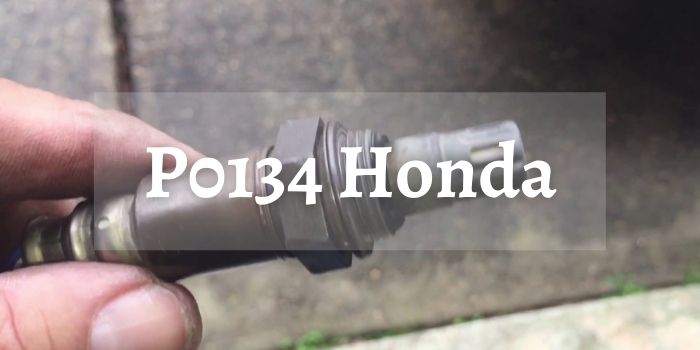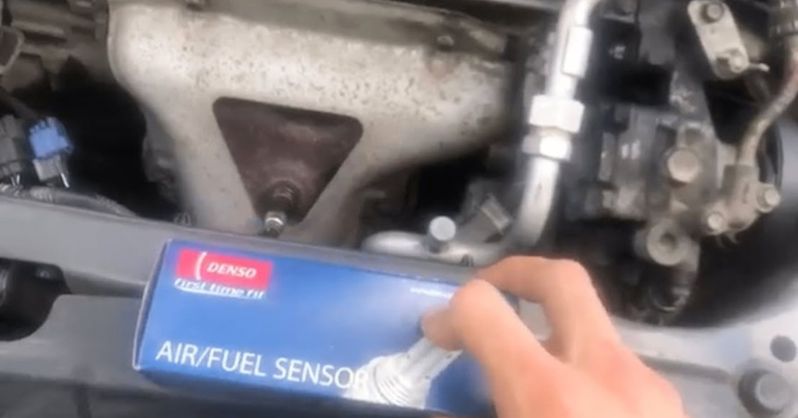Are you noticing a high level of smoke coming out from the exhaust? Seeing that the fuel economy has taken a massive dip? If your engine light is on, there is a high chance that your vehicle has the P0134 Honda issue. And the issue mainly relates to the oxygen sensor.
The front oxygen sensor, otherwise known as the air to fuel ratio sensor, measures the oxygen level present in the exhaust. Based on this measurement, the engine computer will adjust the air to the fuel ratio and keep it at the optimal level.
But what exactly is the P0134 issue? Can you fix it? Let’s take a deep dive into the topic, shall we?

What Does The P0134 Honda Issue Mean?
When you get the P0134 Honda Civic code, it means that the oxygen sensor is malfunctioning. In other words, the signal from the sensor is not changing for a certain amount of time. And in those conditions, the RPM, temperature, and other crucial factors of the engine are not in the optimal range.
In short, a malfunctioning oxygen sensor (bank 1, sensor 1) will only trigger the P0134 code. The Engine Control Module will detect that the sensor is standstill and is not offering accurate reading, making the check engine light up. That said, it has some connections with the obd p0505 honda code, which we’ll talk about later.
Now, as the sensor will not read the right amount of oxygen present in the exhaust, the ECM will malfunction. It will misread the amount of fuel and oxygen coming through the exhaust. And that would eventually inhibit the vehicle from running on the optimal fuel to air ratio.
What Are The Symptoms of the Honda P0134 Issue?
One thing that will be common for all of the engine issues is that they will have some symptoms. Those symptoms can tell you what type of engine code problem you are actually working with. And for the P0134, the symptoms are:
- Higher level of emission
- Check engine light
- Excessive level of smoke from the exhaust
- The engine will run poorly
- A massive dip in fuel economy
Among these symptoms, the fuel economy and engine light are the most common ones. Due to the sensor not mixing up the fuel to air ratio, the engine does not operate at the right temperature. And when the temperature gets excessively hot, the efficiency will also decrease.
What Are The Causes of P0134 Honda?
As we have already mentioned earlier, the P0134 mainly relates to the oxygen sensor. But that does not mean that you can not get the code because of other faults in the vehicle. A lot of other things can cause the issue as well. That includes:
- Faulty or malfunctioning O2 sensor
- The heater circuit is not working properly
- Broken or frayed wiring inside the circuit
- The connection of the oxygen sensor is not right
- There is a leak in the engine vacuum
- A leak in the exhaust
- Faulty ECM
How To fix The Honda P0134 Engine Code?

The P0134 is not that much different from any other engine code such as P0128 Honda Civic code. In other words, with the right steps, you can get it fixed. Wondering what steps are we actually referring to here? Well, let us walk you through:
Step 1: Properly diagnose the issue
Before anything else, you will need to properly diagnose the issue. It will help you to figure out what is causing the problem. And through that data, you will be capable of analyzing whether it is the O2 sensor itself or other parts are contributing to the problem. For this, you can utilize a car scanning tool. That will make things easier.
Step 2: Check for leaks
If you notice that the scanning tool is showing all of the correct readings, you will need to check for leaks. Check the exhaust system and the vacuum lines. Now, when it comes to checking whether these two parts are working optimally or not, you will need to have some prior knowledge and experience.
So, if you feel like you are not fit to check the issue, you should opt for a reliable mechanic. They will be capable of pinpointing exactly what is wrong with your car.
Step 3: Get an estimate and get the issue fixed
Next, you will need to get the estimate for the fix. If you have opted for a reliable mechanic, they will save you from the extra hassles but also save you a good amount of money. How so? They will not suggest you buy the wrong parts, which will just make you waste money.
Nonetheless, if you can pinpoint the problem by yourself, take the necessary steps, purchase replacements, or get the parts fixed.
How To Diagnose The P0134 Issue?
As we have mentioned earlier, it is surely possible to get the issue diagnosed and fixed by yourself. You will just need a little bit of experience and have to follow the right steps. And the steps that we are referring to here are:
Step 1: Use a scanning tool to inspect the engine
Before anything else, you should get yourself a scanning tool to check if there are other issues available or not. If you see that other codes are popping up, you will need to address them before handling this issue.
Step 2: Inspect the wiring and the O2 sensor
Next, visually check the electrical connections, metal tabs, and wire harness. See if you can find any signs of damage in these areas. If you do find that there are signs of damage, replace the sensor.
Step 3: Use a multimeter to check the oxygen sensor
After checking the wires and the O2 sensor, you should check the vehicle repair manual. In the manual, you will be looking to locate the O2 sensor’s harness connector. Put the connectors of the multimeter on those connectors and monitor the voltage.
Then, you will need to disconnect the harness connector. Turn the ignition to the on position but do not crank the car. Test the O2 sensor again and see if it is getting the right level of voltage or not. Inspect the varying voltage, which should be from 0.1- 0.95 volts when the engine is running at an optimal temperature.
If you notice that the voltage is not within the optimal range, you will need to get the oxygen sensor one on bank one replaced.
Step 4: Check for vacuums and exhaust leaks
Finally, you would want to check whether there are any leaks in the vacuum or exhaust. If there are signs of disconnections or cracks inside the tube, you might need to get them replaced.
Is P0134 A Serious Issue?
When it comes to severity, the Honda P0134 is a moderate issue. But that does not mean that it will be okay to drive the car for a prolonged amount of time with the issue on. That will eventually make the engine have internal damages, which will make you spend more money.
For that reason, you should get the issue fixed as fast as possible. That will offer you an optimal driving experience and allow you to extend the life of the engine and other parts associated with the issue.
What Is The Cost To Fix The P0134 Issue?
If you take your vehicle to a repair shop right now, the mechanics will spend about an hour trying to get to the root of the issue. And the time that mechanic will spend on diagnosing the issue will be included in the labor cost. Depending on the rate of the shop, it can be anywhere between $75 and $150.
Now, it will depend on what needs replacing when it comes to replacement costs. For example, the air to fuel ratio sensor will make you spend anywhere from $65 to $320. Yes, you can indeed replace the part on your own and skip the labor cost. But, it would be best if you left the task in the hands of a professional mechanic.
Final Words
The P0134 Honda is a common issue that happens to civic, CRV, city, and other models. And as you know by now, it is an issue that resides at a moderate level when it comes to severity. However, you should not drive with the problem for an extended amount of time. Get it fixed as soon as you notice the symptoms.
Related Posts:
What Is The Powertrain | Learn About the Heart of Your Vehicle
What Are The Symptoms Of A Bad Powertrain Control Module | RoadWeekly
What Is P0021 Ford F150 & How Can It Affect Your Car